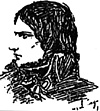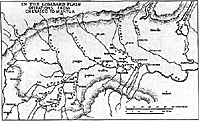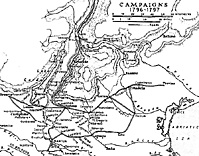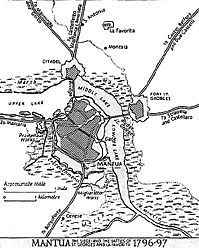 In the previous episode, the Armee de Italie first delivered a number of quick blows to the
Austrian elments of the Coalition forces in northwestern Sardinian territories. General Beaulieu is stunned and defensive to immediate French actions. Then Bonaparte quickly masses his armee against the separated Sardinian units in a manuever d 'centre. The French overwhelm any attempt to present a viable defense. The Sardinian Monarch sues for peace, granting the French what Bonaparte dictates. Bonaparte is now prepared to deal with the Austrians. It is May 1796.
In the previous episode, the Armee de Italie first delivered a number of quick blows to the
Austrian elments of the Coalition forces in northwestern Sardinian territories. General Beaulieu is stunned and defensive to immediate French actions. Then Bonaparte quickly masses his armee against the separated Sardinian units in a manuever d 'centre. The French overwhelm any attempt to present a viable defense. The Sardinian Monarch sues for peace, granting the French what Bonaparte dictates. Bonaparte is now prepared to deal with the Austrians. It is May 1796.
Act 2 Scene I "The Race to Mona"
 The immediate prize to garner is the great city of Milan. The Austrians are expected to defend this regional asset. Beaulieu had withdrawn his forces behind the river Sestia and arrayed a cordon defense along the river lines west and south of the city.
The immediate prize to garner is the great city of Milan. The Austrians are expected to defend this regional asset. Beaulieu had withdrawn his forces behind the river Sestia and arrayed a cordon defense along the river lines west and south of the city.
Large Map 1: 103K
Jumbo Map 1: 299K
Bonaparte does not want to fight across three rivers in his drive on Milan. He plans a demonstration in front of Beaulieu's positions at Valenza on the river Sestia while sending his columns south of the river Po to cross at Piacenza. He intends to avoid head on attacks across all but one possible river obstruction. To lead this operation, Bonaparte assembles a light brigade of consolidated grenadiers and cavalry.
This advanced guard is composed of four battalions of grenadiers, two of carabiniers, and 1,500 cavalry under Dallemagne.
Beaulieu is not completely deceived by the demoristration to his front and is deploying forces on the northern banks along the Po to challenge any crossings. General Liptay is instructed to cover around Pavia and crossing east. He has seven battalions and six squadrons, approximately 6,000 men. On the 6th, Beaulieu marches with another 6,000 to Pavia, pushing Liptay further east toward Piacenza. As with earlier Austrian efforts, the reaction is too little, too late. By two on the afternoon of the 7th, Lannes is the first to land on the north side of the Po with the grenadiers of Dallemagne's composite force. The lead elements of Laharpe's division immediately follow. Austrian outposts are alerted.
As Dallemagne pushes out from the bridgehead on the 8th, elements from both armies initially clash at Fombio on the north side of the Po. Here Liptay's command is ejected from the fortified village by the advanced guard attacking from the Wont and Lahalpe's division from the flank.
Excess valor
During this combat, Lannes is accused of bringing up his men so awkwardly that he not only kills 80, wounds 200, and captures 700 of the enemy, but also kills 150 and wounds 300 of Landrieux's command. [So much for perfect command and control sought by many rules lawyers.] 'Lannes is well known. He is the bravest man in the army, but he would have done well to remain a grenadier. Excess in valor is, in a leader, a great misfortune for the troops of he commands. They must be reinforced unceasingly.' Liptay falls back towards Pizzighettone. Bonaparte directs Laharpe's division towards Casale where Beaulieu's forces are believed massed.
That night a converging force under Beaulieu discovers Laharpe's division camped for the evening. As at Dego, the French are surprised. The Austrian advanced guard strikes at 2 am. Unfortunate combat fratricides continues with Laharpe killed by a shot from his own men in the confusion. Dallemagne, Lannes, and Berthier are able to restore order. Beaulieu discovering that Liptay has already withdrawn, decides also to retire further east. Just out of reach of Laharpe's counter-attacking division now lead by Berthier, he moves toward Lodi.

This time the Austrians win the foot race. After gathering the remainder of the French forces crossing the Po, Bonaparte's pursuit is lead by Dallemagne's avant-garde only catches Beaulieu's rearguard at Lodi.
Large Map 2: 110K
Jumbo Map 2: 310K
Austrian General Sebottendorf has approximately 7,500 infantry, 2,500 horse, and fourteen guns. The latter are arrayed on the east bank of the only bridge across the Adda River. Bonaparte oversees the placement of 24 French guns and literally directs the bombardment of the Austrian defenses.
With Massena's division closing, Bonaparte launches Dallemagne's grenadiers across the bridge. Swept by case shot, the column is checked. Messena, Dallemagne, Cervoni, and Berthier, join Lannes already in the column, shouting, inspiring, leading. [Let's see, that's 2 inspirational and 3 excellent commanders attached to one combat element At least a plus 10 on my die! ] The column impacts the defenders on the east side of the river, just as Ordener with some French cavalry arrives from a fording the Adda and takes the Austrians in flank. The Austrians recoil, losing 153 killed, 182 wounded, 1,701 prisoners, and the guns as the remnants fly towards Crema. Milan was now open.
On 13 May, Massena's division with the avant-garde lead by Joubert entered Milan. These two generals host General Bonaparte, surrounded by his guides, the next day with a triumphal entr, into the city. This joyous celebration is to be short lived by the locales. The Armee continued its march eastward after the Austrians. After passing through Lodi again, a new headquarters is established in Crema, now evacuated by the Austrians. Berthier takes temporary command.
The excesses of an army relying upon forage for sustainment and larcenous looting by Republican officials provoked the general population into revolt. With the commands of Marmont and Murat, Bonaparte first returns to Milan and then as far west as Tortona. Pavia is subjected to systematic plundering. On the 24th, Lannes took the small town of Binasco which lies between Milan and Pavia, where the peasants had collected arms. Here he orders no quarter be given. The women and children were removed. The men were killed. The village burnt to th. ground.
The rational given was that the safety of the army required a great example. These foul actions need to be pondered along with the traditional accolades of glory and honor.
Withdrawal
By now Beaulieu has withdrawn to the Mincio River with the intention of withdrawing up the Adige River towards the Tyrol. He is headquartered at Valeggio with his right at Peschiera and his left, under Colli, at Goito. Colli has been reinforce with troops from Mantua.
Bonaparte returns on the 26th to continue the offensive. On the 29th, Massena fords at Borghetto and strikes directly at Valeggio almost bagging Beaulieu who is forced to flee form his bed. Serurier demonstrates before the enemy further down the river. Augereau advances towards Peschiera but is check by a counter-attacking Liptay. However, Liptay chooses to retire east on Castelnovo.
Finding their defenses breached, the Austrian center and right retreat and bridge the Adige at Chiusa and by Verona to escape. Colli, commanding the left, first marches to the sound of the guns to his north. Hearing what has befallen the main body of the army, he elect to send his cavalry to join Beaulieu via Villafranca and the take his infantry and guns to Mantua. Beaulieu retires north to the Tyrol seeking to reform his army.
Tactically, for the first time in the campaign, the French now face a cavalry threat. Having fought the enemy in the rugged Alps and Apennines, they were not as firm against mounted troops. When the 18th Regiment under Suchet, in Victor's division, crosses the Adige it suffers under the assault of a Neapolitan cavalry force. Murat leading two Chasseur regiments counter charged taking nine guns, two colours, 2,000 men, including the Prince de Cuto.
The French move quickly. Massena marches east to occupy Verona on I June. He then proceeds to the Adige River valley to watch the remaining mass of the enemy. Serurier turns south to Mantua taking La Favorita to the north of the town. Augereau leaves Peschiera to occupy the village of Cerese just south of the city. On the 3rd, Dallemagne's forces occupy the tete-du-pont of St. Georges. The race has been run. Mantua, the last Austrian fortress in the region, is now invested.
Act 2 Scene 2 "A Brief Italian Holiday"
With the Austrians subdued for the moment, the politics and intrigues of Paris intervene. Concerned over the success of this young general in Italy, the Directory proposes to divide the now large Italian gains between Kelleftmann and his Armee del Alpes and Bonaparte's Armee d'Italie. Bonaparte responds as effectively against this plan as he has Beaulieu and his army. He forces the issue of unity of command by demanding the designation of a single commander of all the forces while sending lavish 'gifts' composed of 'liberated' goods and gold from the cities and treasuries of the Lombardy Plain. No more sterner stuff than, let's say, Congressmen, the Directors see the light, disband the Armee del Alpes, and distribute the manpower among Bonaparte's formations. Back to the war.
 The strength of the defenses of Mantua lie not in it walls, but in the marshes and lakes which encompass its parameter. These natural physical defenses are allied with the ever present and statistically more lethal natural weapon of mosquito borne diseases. However, both of these
played against the assailant and defender.
The strength of the defenses of Mantua lie not in it walls, but in the marshes and lakes which encompass its parameter. These natural physical defenses are allied with the ever present and statistically more lethal natural weapon of mosquito borne diseases. However, both of these
played against the assailant and defender.
The water makes it hard for the attacker to conduct an assault, but also makes it hard for the garrison to sally out. While the mosquito respects no uniform, it will extract a price of 50 Frenchmen a day.
The French face a long waiting period being without proper siege artillefty to hasten the town and the garrison's surrender. As a method to acquire some appropriate ordnance and to add to their own and the Directory's coffers, a good portion of the Armee is sent on a tour of the more lucrative areas. While Serurier is given command over local siege operations, columns composed of Augereau's division and a force under Vaubois with troops from Kellermann's Armee des Alpes head south.
In the latter, General Murat command the advanced guard composed of two cavalry regiments and a battalion of grenadiers commanded by Lannes. Augereau moves to Bolonga with 4,820 men to squeeze the locales for material and funds. Augereau takes the opportunity to line his own personal holdings as well as that of the Republic.
Revolt
He is distracted on 5 July as another revolt by the civil population once again results in terrible suffering. As a few French soldiers were killed in the village of Lugo, the entire town is burnt, pillaged, and, after removing all the women and children, the men killed. Meanwhile, Vaubois with 7,600 men arrives before Modena which provides mary of the much sought after cannon to assist in the Mantua siege.
Marmont and his section rides right past guards and sentries to seize Fort Urban before Modena and secure 28 guns. He is then dispatched to Ferrara were he summons forth the governors who in turn supplied additional artillery to the French. By now Bonaparte had join Vaubois as the command was headed to the Arno. There Murat was sent flying to pinch the English at Leghorn, only to discover they had departed for Corsica. At least the port would be denied the English for further operations. Murat, Berthier, and Bonaparte enter Florence on the 1st of July. Bonaparte's army is now subsidizing the Republic's operation.
A million francs is sent to the armies on the Rhine, even more to the Directory. While other commanders are begging for moneys, he is supplying it. With his own troops now paid, he is their master. No other leader in the Republic has attained this ability. And now Josephine is in Milan awaiting him. It has been a very good holiday. It is about to end.
Next - Act 3 "The Empire Strikes Back"
Back to MWAN #88 Table of Contents
Back to MWAN List of Issues
Back to MagWeb Magazine List
© Copyright 1997 Hal Thinglum
This article appears in MagWeb (Magazine Web) on the Internet World Wide Web.
Other military history articles and gaming articles are available at http://www.magweb.com